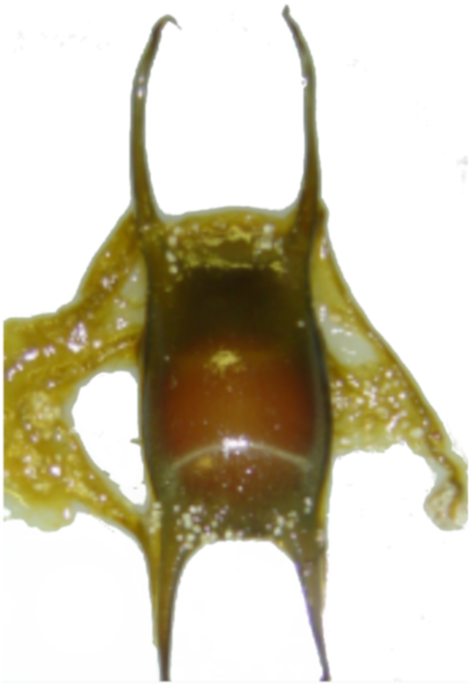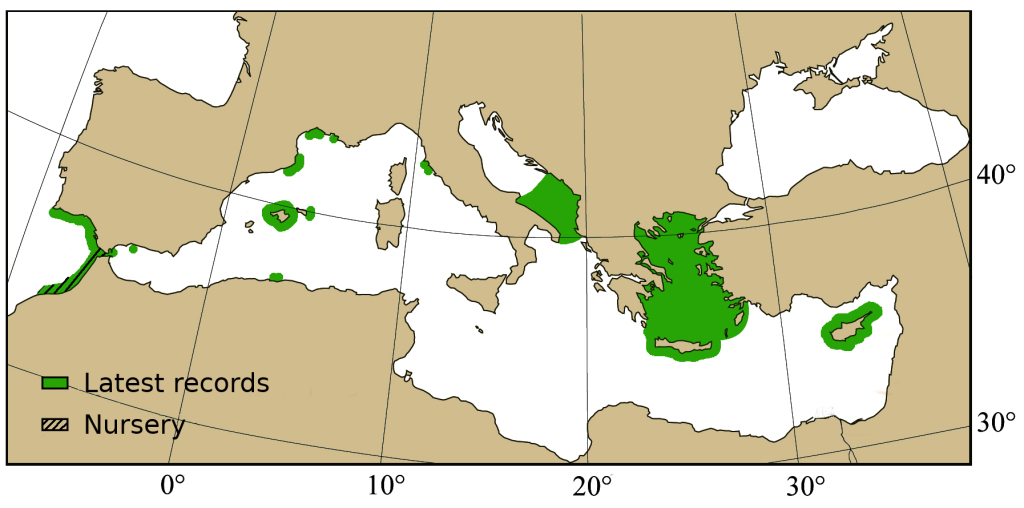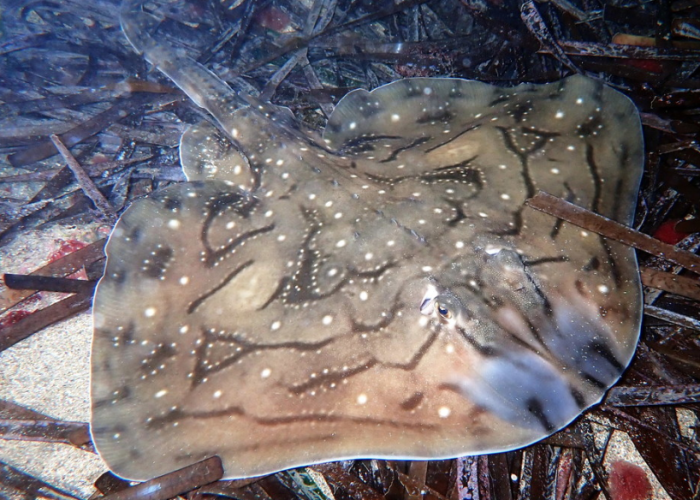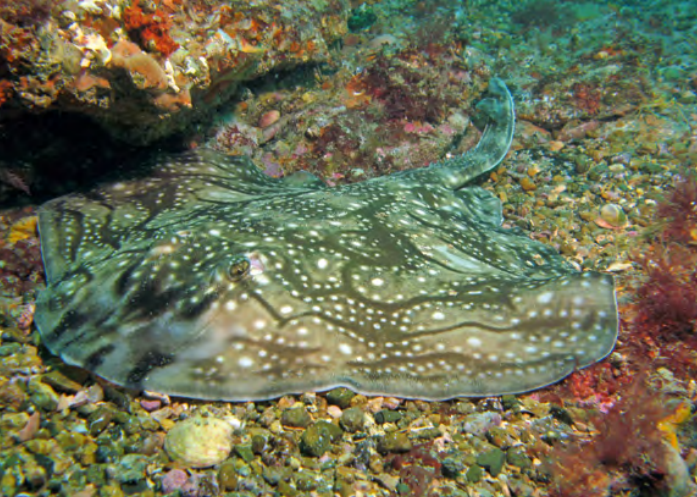Raja undulata
Common name : Undulate Skate
Order: Rajiformes
Family: Rajidae
Synonyms: None
Misidentifications: None
Short description
Medium-bodied skate, circular body with pectoral fins wider than long and an edge forming a sinuous curve. Short snout. Spiny dorsal surface with smooth areas on the central parts and posterior disc. Row of 2-8 spines along the neck. Smooth ventral surface but not on the snout and front end.
Color: Ochre to grayish-brown dorsal surface, with several dark undulating bands and edged with white spots. White ventral surface.
Measurements:
- Total length (TL): up to 120 cm
Swimming pattern: Undulatory and pelvic fin locomotion (walking and punting).
Egg case

Oblong capsules covered by fibers with stiff pointed horns at the corners deposited in sandy or muddy flats.
Size: 5-9 cm length, 4.2-5.2 cm wide.
Distinctive features:
- Capsule width ≥ 45 mm
Raja: Long posterior horns. Anterior horns length less than twice the posterior.
Rajiformes / Rajidae: Rectangular egg-case, width no greater than twice the capsule length.
Biology / Ecology
Feeds on all kinds of bottom animals (small fish, crustaceans, mollusks and other macrobenthic organisms).
Reproduction: Oviparous. Eggs per year: 30-90. Size at maturity (TL): 71-78 cm males, 75-84 cm females. Size at birth (TL): 14 cm. Differences in reproduction season, size at first maturity, generation length and/or growth rate were observed between populations, probably related to water temperature.
Habitat: Demersal in shallow waters to about 300 m on soft and sandy bottoms. Inshore with fragmented range with a small number of discrete areas. Small specimens have been reported in coastal lagoons, rías, and just outside estuaries which may be nursery areas. Depth: 0-300 m (more common at depths <50 m).
Little data on the biology of this species due to its rarity and the depth where it lives.
Distinguishing characteristics
- Several undulating dark bands with white spots
- Snout short
Rajiformes / Rajidae: Depressed body. Circular to rhombic disc. Tail well demarcated from disc.
Distribution
Worldwide: Patchy and discontinuous distribution in the North Atlantic, from the south of Ireland to Senegal.
Mediterranean: Found very sporadically across the Mediterranean Sea.
- Occurrence: Rare.
- Latest records: Gulf of Cadiz – Spain (2018), Cyprus (2017), Portugal (1986-2017), Atlantic – Morocco (2016; including juveniles) Cretan and Aegean Sea (2012-2015), Balearic Sea (2001).

Any recent observation not on the map?
Contact us!
Conservation
Threats: Caught by trawl, trammel net, and other demersal fisheries, mainly as bycatch but often retained. Considered of high value in fisheries. Fragmented distribution possibly with little exchange. Suspicion of decline of habitat quality of inshore and estuarine habitats as a result of contamination (urban and industrial pollution), shipping, dredging navigation channels, aquaculture, and other habitat modification.
Protection level:
- Global range: Endangered (IUCN 2009, last assessment: 2003)
- Europe: Near Threatened (IUCN 2015, last assessment 2015)
- Mediterranean: Near Threatened (IUCN 2016, last assessment: 2016)
Key references
- Coelho R, Erzini K. 2002. Age and growth of the undulate ray, Raja undulata, in the Algarve (southern Portugal). J Mar Biol Assoc UK 82(6): 987–990.
- Coelho R, Erzini K. 2006. Reproductive aspects of the undulate ray, Raja undulata, from the south coast of Portugal. Fish Res 81(1): 80–85.
- Giovos I., Serena F., Katsada D., Anastasiadis A., Barash A., Charilaou C., Hall-Spencer J.M.,Crocetta F.,Kaminas A., Kletou D, Maximiadi M., Minasidis V., Moutopoulos D.K., Aga-Spyridopoulou R.N., Thasitis I., Kleitou P. 2021. Integrating literature, biodiversity databases, and citizen-science to reconstruct the checklist of Chondrichthyans in Cyprus (Eastern Mediterranean Sea). Fishes 6(3): 24.
- Follesa M. C., Marongiu M. F., Zupa W., Bellodi A., Cau A., Cannas R., Colloca F., Djurovic M., Isajlovic I., Jadaud A., Manfredi C., Mulas A., Peristeraki P., Porcu C., Ramirez-Amaro S., Salmerón Jiménez F., Serena F., Sion L., Thasitis I., Cau A., Carbonara P. 2019. Spatial variability of Chondrichthyes in the northern Mediterranean. Scientia Marina 83(S1): 81-100.
- Soldo A., Lipej L. 2022. An Annotated Checklist and the Conservation Status of Chondrichthyans in the Adriatic. Fishes 7(5): 245.
- Villagra D., Van Bogaert N., Ampe B., Walker P., Uhlmann S. S. 2022. Life-history traits of batoids (Superorder Batoidea) in the Northeast Atlantic and the Mediterranean. Reviews in Fish Biology and Fisheries: 1-23.



